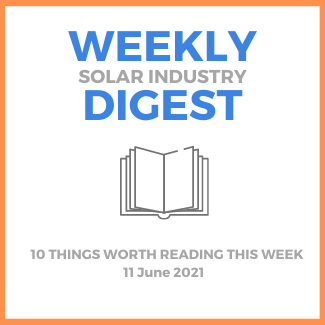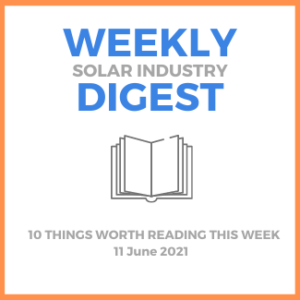Top risks to investor returns and industry credibility around the world are increased solar asset underperformance due to problems with financial modeling, operational performance and extreme weather. The median annual degradation is 1.09% for res systems and 0.8% for non-res systems, making annual asset degradation higher than expected.
Soligent has begun a webinar series on inverter solutions. One video focuses on SMA’s ShadeFix, their integrated inverter technology designed to optimize system energy production – even when shading hits. Another video examines SolarEdge’s Energy Hub and how it provides standardizing in one solution and the advantages of flexible design.
Q1 2021 had 910 MWh of new energy storage systems, an increase of 252% over Q1 2020. This is the 3rd highest megawatt-total for one quarter in the US. Numbers are predicted to show 12,000 MWh of new storage in 2021, 3x the amount of new storage added in 2020. All this is bolstered by the introduction of the stand-alone ITC in Congress.
Biden is ending talks with WV Republican Senator Shelley Moore Capito over the infrastructure bill – both sides were $700 billion apart after the GOP’s final offer. Instead, Biden will engage with a bipartisan group of 20 senators in order to try to quickly find something that will meet his goals and nab at least 10 GOP votes.
There’s a new large res installer in town. Five res solar providers, Atlantic Key Energy (FL), Deca (TX), LIFT Energy (UT), Our World Energy (AZ) and Smart Energy Today (WA), have merged to form Lumio. They’ll offer streamlined installs and home improvement projects like new roofs, battery backup systems and smart tech upgrades.
Trials across the country for NREL’s SolarAPP, the app that automates the permitting process for res systems, have shown that the platform reduces time to grant a permit from a national average of 5 biz days to 0 and lowers soft costs from PII. Partners have included municipalities in AZ and CA and contractors such as Tesla, SunPower, and SunRun.
With the housing market boom homebuyers are running into aging solar systems fraught with mechanical and electrical hazards like fire starters and impending leaks. Top issues include home buyers needing to foot the bill for repairs, early adopters with problematic lags/sealant fasteners (vs. aluminum/flexible flashing) and critter damage.
Problem: while a greater portion of the world has electricity numbers in Sub-Saharan Africa and India have declined. Solution: scaling up decentralized renewable-based solutions via beefed up political commitment, energy planning over the long term, policy and scale incentives, and more public sector financing in a post-COVID context.
The DOE is offering a $5 million fifth round competition with tracks for both hardware and software innovations. The DOE seeks to push for the commercialization of products designed for equitable solar energy deployment and domestic manufacturing. There’s also a new AI tool linking innovators with DOE’s national labs and biz incubators.
The FERC chair laid out some short and long-term goals for transmission policy, saying they’ll outline a path forward on those issues soon. He talked about maximizing current US transmission and taking a new approach on interregional transmission planning by broadening how benefits are calculated when allocating costs for such projects.


